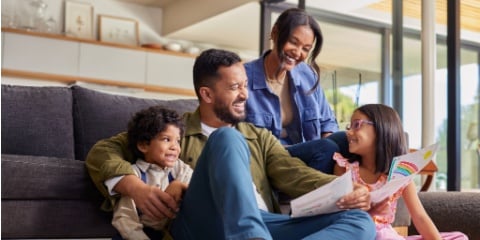10 Practical Tips to Apply Bibliotherapy for Kids

Unlock Daily 30-Sec Tips for a Happier Relationship
👉 Subscribe FREEKey Takeaways
Marriage.com AI Quick Summary
In an age where screens often dominate leisure time, the timeless practice of reading holds new promise for the younger generation. Bibliotherapy, a method that leverages the therapeutic power of reading, is gaining recognition as a valuable tool for children’s emotional and psychological well-being.
Hence, let’s understand the essence of bibliotherapy for kids, outline its benefits, and provide a practical guide to integrating this approach into the lives of young readers.
What is bibliotherapy for kids?
Bibliotherapy for children is a guided process that involves the use of literature to support children’s mental health, emotional development, and coping strategies. Bibliotherapy books for kids harness the power of stories, characters, and scenarios to address specific issues, provoke thought, and evoke empathy.
A review study found that bibliotherapy is effective in enhancing self-concept and lowering aggression in students with challenging behaviors.
Through identification with characters and situations, children learn to handle their own feelings and challenges, making bibliotherapy activities for kids a unique bridge between the imaginary and real worlds.
According to Maggie Martinez, LCSW:
Bibliotherapy gives children relatable narratives that normalize their feelings, helping them understand and process emotions in a safe way.
5 benefits of bibliotherapy for kids
Bibliotherapy for children is not just about reading; it’s about healing, growing, and learning through literature. This therapeutic approach offers a myriad of benefits that extend well beyond the pages of a book.
Here are 5 significant benefits of bibliotherapy for kids, each illustrating the profound impact that children’s bibliotherapy can have on young minds.
1. Enhances emotional intelligence
Books selected for kids’ book therapy provide relatable scenarios that mirror real-life situations, allowing children to see their own feelings and reactions reflected in the characters. This process helps them recognize and name their emotions, nurturing emotional intelligence.
Children learn to identify and express their feelings more effectively by understanding what characters are going through, which is crucial for emotional development.
2. Boosts coping skills
Children’s mental health books are carefully chosen to include narratives that present characters facing and overcoming challenges. This shows children that they are not alone in their struggles and introduces various coping strategies in a context they can understand.
As they see characters overcome adversity, children learn practical ways to deal with their problems, enhancing their resilience.
3. Promotes empathy
Children are exposed to diverse characters and situations through bibliotherapy, broadening their perspectives and cultivating empathy.
Reading stories about people from different backgrounds, cultures, and life experiences can help kids develop a deeper understanding and compassion for others. This empathy is a key component of emotional intelligence and social skills, enabling more positive interactions with peers and adults.
Maggie Martinez highlights that:
Bibliotherapy allows children to explore challenges through reading, encourages self-reflection, and teaches problem-solving skills.
4. Strengthens self-esteem
The challenges and triumphs of characters within bibliotherapy narratives can serve as powerful mirrors for children, reflecting their potential for growth and success.
When kids see characters overcoming obstacles, it reinforces the idea that they, too, can face and conquer their difficulties. This can significantly boost self-esteem and encourage a positive self-image.
Maggie Martinez Schulz adds that:
Books can serve as mirrors and windows for children. They help them reflect on their own actions and offer perspectives on coping skills.
Research has shown that children often identify with characters in stories during bibliotherapy, as they may encounter similar problems or challenges. This ability to perceive these similarities greatly enhances the effectiveness of bibliotherapy for children.
5. Encourages a love for reading
Engaging in bibliotherapy can ignite a passion for reading that lasts a lifetime.
Children who participate in bibliotherapy are introduced to a wide range of literature that not only entertains but also heals and educates. This promotes an appreciation for books as sources of pleasure, wisdom, and comfort, laying the foundation for continuous learning and development.
10 effective steps to apply bibliotherapy for kids
Implementing bibliotherapy in the lives of children can be a transformative experience, guiding them through emotional landscapes with the gentle wisdom found in books.
Here are 10 effective steps to apply bibliotherapy for kids, ensuring a meaningful journey through the pages of children’s therapy books and nurturing resilience, empathy, and understanding.
1. Understand the child’s emotional landscape
The first step in utilizing children’s therapy books is to assess the child’s emotional and psychological needs comprehensively.
Whether addressing feelings of anxiety, themes of bullying, or the complexities of family dynamics, understanding the specific issues at hand guides the selection of literature that resonates deeply with the child’s experiences, ensuring a targeted and effective bibliotherapeutic intervention.
2. Curate a tailored book selection
Choosing the right books is paramount in child therapy through books. This can involve finding stories that mirror the child’s emotional experiences, providing them with characters and narratives they can identify with.
The selection process should prioritize books that are not only age-appropriate but also rich in positive resolutions and coping mechanisms, offering both comfort and constructive strategies for the child to emulate.
3. Design a nurturing reading space
Creating a dedicated, comfortable reading environment is crucial for the success of bibliotherapy. This space should be inviting and free of distractions, encouraging the children to immerse themselves fully in the reading experience.
A nurturing environment supports emotional openness and engagement, laying the groundwork for a therapeutic and transformative journey through books.
4. Engage in shared reading experiences
Reading together promotes a supportive atmosphere, which is essential for managing the emotional themes within kids’ emotional wellness books.
Shared activity not only strengthens bonds but also provides a foundation for discussions about the book’s content and its relevance to the child’s life, making the therapeutic process collaborative and inclusive.
5. Facilitate reflective discussions
Post-reading discussions are vital, offering a platform for the child to articulate their thoughts and feelings about the story.
These conversations should be guided by open-ended questions that encourage deep reflection and connection, allowing the child to explore their emotions and the moral and emotional lessons of the narrative in a safe and supportive environment.
6. Promote identification with characters
Encouraging children to find parallels between themselves and the characters in the story is a powerful aspect of bibliotherapy.
Such an identification process can help children understand that they are not alone in their struggles, providing them with models of resilience and problem-solving that they can apply to their own lives, thus enhancing the therapeutic value of the reading material.
7. Highlight and discuss coping mechanisms
A key component of kids’ emotional wellness books is the depiction of various coping strategies.
It’s important to discuss these strategies explicitly with the child, exploring how characters manage their challenges and how similar approaches can be adapted to the child’s own situations. This can reinforce positive coping mechanisms and empower the child to handle their issues proactively.
8. Incorporate expressive activities
In order to deepen the therapeutic impact, bibliotherapy should be complemented with creative activities related to the book’s themes.
Whether through art, writing, or role-playing, these activities allow children to express their feelings and insights in a tangible way, facilitating a deeper emotional processing and understanding of the story’s messages.
Watch this TED Talk where Austeja Landsbergiene shares how you can perform responsible parenting, creating memories and not expectations for your child:
9. Monitor and adapt to the child’s evolving needs
Ongoing assessment of the child’s response to bibliotherapy is essential.
Regular check-ins and discussions about their feelings and any behavioral changes since engaging with the therapy provide insights into the effectiveness of the chosen literature and the overall therapeutic approach, allowing for adjustments to the reading material as the child’s needs and circumstances evolve.
10. Collaborate with mental health professionals when necessary
For children facing more complex emotional or psychological challenges, it’s beneficial to collaborate with mental health professionals.
These experts can offer valuable guidance on the bibliotherapy process, recommend specific titles that address intricate issues, and ensure that the therapeutic reading aligns with broader therapeutic goals, maximizing the benefits of bibliotherapy for the child.
FAQs
Bibliotherapy is a unique and powerful way to support children’s emotional growth through the world of books. Here are some frequently asked questions about implementing bibliotherapy at home, providing insights and practical tips for parents exploring this therapeutic approach.
-
How can parents engage their children in discussions about the books they read during bibliotherapy sessions?
Parents can ask open-ended questions to engage children in discussions, encouraging them to express their thoughts and feelings about the story and its characters. Discussing how the book relates to their experiences and exploring the characters’ decisions and outcomes can deepen the child’s understanding and connection to the material.
-
Are there any potential risks or limitations to using bibliotherapy to support children’s emotional well-being?
The primary limitation of bibliotherapy is selecting books that may not be directly relevant to the child’s specific emotional needs or development stage, potentially leading to disinterest or misunderstanding. Overreliance without professional guidance for serious issues could also miss addressing deeper psychological needs.
-
How often should parents incorporate bibliotherapy into their child’s routine, and for how long?
Bibliotherapy can be incorporated into a child’s routine 2-3 times a week, with sessions lasting from 20 to 30 minutes, depending on the child’s age and attention span. Consistency and patience are key to allowing the child to absorb and reflect on the stories’ messages.
-
What should parents do if they notice that a book triggers strong emotions or reactions in their child?
If a book triggers strong emotions, addressing the child’s feelings openly and supportively is essential. Pause the reading and allow the child to express what they’re feeling. Use the opportunity to discuss and process these emotions together, providing reassurance and understanding.
-
Are there resources or organizations that provide recommendations for bibliotherapy books for children?
Many organizations and websites offer curated lists of bibliotherapy books for children, categorized by age and topics addressed. Libraries, child psychologists, and educational websites are valuable resources for finding books tailored to specific emotional and developmental needs.
Takeaway
Bibliotherapy for kids offers a creative and impactful way to address children’s mental health and emotional development. By carefully selecting literature that resonates with their experiences, parents and educators can provide children with invaluable tools for managing life’s challenges.
As we cultivate a deeper connection between young readers and the world of books, we open the door to healing, growth, and a lifelong love of reading. Engaging in bibliotherapy is a journey worth taking, promising a blend of comfort, discovery, and empowerment for children at every turn.
 Tips
Tips
Write your tip or submit a video tip
All tips are reviewed before the publishing.
Share this article on
Want to have a happier, healthier marriage?
If you feel disconnected or frustrated about the state of your marriage but want to avoid separation and/or divorce, the marriage.com course meant for married couples is an excellent resource to help you overcome the most challenging aspects of being married.
Recent Articles
Related Quizzes
Unlock Daily 30-Sec Tips for a Happier, Healthier Relationship
👉 Subscribe FREE on YouTube We'd love your feedback!
We'd love your feedback!
 Expert Q&A
Expert Q&A
Ask your question related to this topic & get the support you deserve from experts.



















 Thanks for your feedback!
Thanks for your feedback!